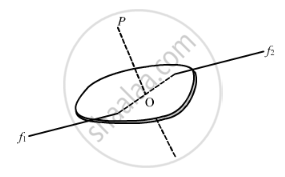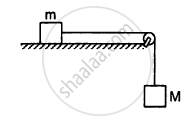Advertisements
Advertisements
प्रश्न
Particles of masses 1 g, 2 g, 3 g, .........., 100 g are kept at the marks 1 cm, 2 cm, 3 cm, ..........., 100 cm respectively on a metre scale. Find the moment of inertia of the system of particles about a perpendicular bisector of the metre scale.
उत्तर
It is given that the perpendicular bisector of the metre scale is passed through the 50thparticle.
Therefore, on the L.H.S. of the axis, there will be 49 particles and on the R.H.S., there will be 50 particles.
Consider the two particles positioned at 49 cm and 51 cm.
Moment of inertia due to these two particles = 49 × (1)2 + 51 × (1)2
I1 = 100 × 1 = 100 gm-cm2
Similarly, if we consider particles positioned at 48 cm and 52 cm, we get
I2 = 100 × (2)2 gm-cm2
Thus, we will get 49 such sets and one particle at 100 cm. Therefore, total moment of inertia,
\[I = \left( I_1 + I_2 + I_3 . . . . . + I_{49} \right) + I'\]
Here, I' is the moment of inertia of particle at 100 cm.
\[So, I = 100 \left( 1^2 + 2^2 + 3^2 + . . . + {49}^2 \right) + 100 \left( 50 \right)^2 \]
\[ = 100 \left( 1^2 + 2^2 + 3^2 + . . . + {50}^2 \right)\]
\[ = 100 \times \frac{\left( 50 \times 51 \times 101 \right)}{6}\]
\[ = 100 \times 25 \times 17 \times 101 = 4292599 gm - {cm}^2 \]
Or, I = 0.429 kg-m2 ≃ 0.43 kg-m2

APPEARS IN
संबंधित प्रश्न
If the ice at the poles melts and flows towards the equator, how will it affect the duration of day-night?
A circular disc A of radius r is made from an iron plate of thickness t and another circular disc B of radius 4r is made from an iron plate of thickness t/4. The relation between the moments of inertia IA and IB is __________ .
The centre of a wheel rolling on a plane surface moves with a speed \[\nu_0\] A particle on the rim of the wheel at the same level as the centre will be moving at speed ___________ .
A wheel of radius 20 cm is pushed to move it on a rough horizontal surface. If is found to move through a distance of 60 cm on the road during the time it completes one revolution about the centre. Assume that the linear and the angular accelerations are uniform. The frictional force acting on the wheel by the surface is ______________________ .
A solid sphere, a hollow sphere and a disc, all having same mass and radius, are placed at the top on an incline and released. The friction coefficients between the objects and the incline are same and not sufficient to allow pure rolling. Least time will be taken in reaching the bottom by ___________ .
Consider a wheel of a bicycle rolling on a level road at a linear speed \[\nu_0\] (see the following figure)
(a) the speed of the particle A is zero
(b) the speed of B, C and D are all equal to \[v_0\]
(c) the speed of C is 2 \[v_0\]
(d) the speed of B is greater than the speed of O.

Three particles, each of mass 200 g, are kept at the corners of an equilateral triangle of side 10 cm. Find the moment of inertial of the system about an axis passing through one of the particles and perpendicular to the plane of the particles.

Find the moment of inertia of a pair of spheres, each having a mass mass m and radius r, kept in contact about the tangent passing through the point of contact.
The moment of inertia of a uniform rod of mass 0⋅50 kg and length 1 m is 0⋅10 kg-m2about a line perpendicular to the rod. Find the distance of this line from the middle point of the rod.
The radius of gyration of a uniform disc about a line perpendicular to the disc equals its radius. Find the distance of the line from the centre.
Find the moment of inertia of a uniform square plate of mass m and edge a about one of its diagonals.
Suppose the rod in the previous problem has a mass of 1 kg distributed uniformly over its length.
(a) Find the initial angular acceleration of the rod.
(b) Find the tension in the supports to the blocks of mass 2 kg and 5 kg.
The following figure shows two blocks of mass m and M connected by a string passing over a pulley. The horizontal table over which the mass m slides is smooth. The pulley has a radius r and moment of inertia I about its axis and it can freely rotate about this axis. Find the acceleration of the mass M assuming that the string does not slip on the pulley.

A metre stick weighing 240 g is pivoted at its upper end in such a way that it can freely rotate in a vertical place through this end (see the following figure). A particle of mass 100 g is attached to the upper end of the stick through a light string of length 1 m. Initially, the rod is kept vertical and the string horizontal when the system is released from rest. The particle collides with the lower end of the stick and sticks there. Find the maximum angle through which the stick will rise.

A sphere of mass m rolls on a plane surface. Find its kinetic energy at an instant when its centre moves with speed \[\nu.\]
A small spherical ball is released from a point at a height h on a rough track shown in the following figure. Assuming that it does not slip anywhere, find its linear speed when it rolls on the horizontal part of the track.

